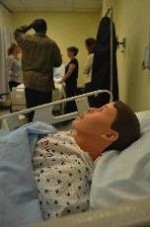Nursing for dummies

Have you ever walked past the nursing wing and had to take a second look at the life-like mannequins lying in the beds? Well, these highly technological and very expensive mannequins ain’t no dummies and are taking hands-on learning to a new level. Mannequins have been around the Castleton nursing program for about 20 to 25 years. Different models with different levels of technology have been in and out of the wing, but the nursing department is dropping $12,000 on each of these new additions, including four adults and one child.
And with these new patients, the old ones aren’t needed anymore. But they likely won’t be headed to a morgue of any sort.
Kelley McAfee, the nursing department lab coordinator, is very optimistic about donating the older mannequins.
“We would like to donate them somewhere local for educational purposes,” McAfee said. “We are recycling them really; we are very sustainable here in the nursing department.”
With the old ones being donated, the new ones are ready to be used by the students – and they are very excited. Sophomore Amanda Kelly is psyched to work on the new mannequins.
“It’s really nice that we can learn different things with the mannequins,” Kelly said. “They can have different symptoms for different reasons, so the span of learning is wide open.”
McAfee is also excited about the teaching possibilities these new not-so-dumb dummies provide.
“The new mannequins have state of the art technology that is all controlled by individual remotes,” McAfee said.
Students can read the mannequins’ heartbeats, check blood pressure, inject medicine and test breathing patterns, she said.
“They are like real people, the only things they don’t do is talk and have flowing blood,” said graduate student Katelyn Savoy.
Savoy said she came to Castleton to do her graduate courses because she knew how the hands-on work that professors incorporate into the learning process.
“The nursing professors have designed a method to monitor the students while they are doing a planned activity and allow the students to do the situation the best they can. After the activity is done the teachers will share what they did well and what could have done better. Essentially, students are making their own mistakes so they can learn from them” Savoy said.
The methods, according to McAfee, really benefit the students.
“One of the cool things about all of this is that the student has evaluated their own actions in their head during the activity and the often know what they can improve on. This really is the key… if the student can identify the areas of growth for themselves, they can begin to make the behavior adjustments and improve their own role development as a nurse,” McAfee said.
This process is called verbal debriefing and professors said these discussions after the activity are essentially to the learning process.
Professors are hopeful in the near future they can buy an $85,000 mannequins that has blood flowing and can talk. For now, though, they’re happy with the new mannequin family.
“Without the new mannequins in the nursing department, the hands on part of learning wouldn’t be there for the students. It’s key that the students can listen to the mannequins, work on them and find out what’s wrong with them. You can’t do that if you are learning out of a book. In nursing, hands on is really the only way to learn,” McAfee said.






